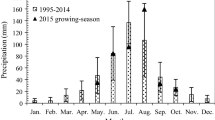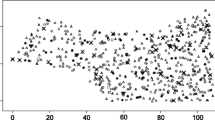Abstract
In a pristine evergreen rainforest of Nothofagus betuloides, located at the Cordillera de los Andes in southern Chile (41 °S), concentrations and fluxes of nutrients in bulk precipitation, cloud water, throughfall water, stemflow water, soil infiltration and percolation water and runoff water were measured. The main objectives of this study were to investigate canopy-soil-atmosphere interactions and to calculate input-output budgets. From May 1999 till April 2000, the experimental watershed received 8121 mm water (86% incident precipitation, 14% cloud water), of which the canopy intercepted 16%. Runoff water volume amounted 9527 mm. Bulk deposition of inorganic (DIN) and organic (DON) nitrogen amounted 3.6 kg ha−1 year−1 and 8.2 kg ha−1 year−1 respectively. Occult deposition (clouds + fog) contributes for 40% to the atmospheric nitrogen input (bulk + occult deposition) of the forest. An important part of the atmospheric ammonium deposition is retained within the canopy or converted to nitrate or organic nitrogen by epiphytic bacteria or lichens. Also the export of inorganic (0.9 kg ha−1 year−1) and organic (5.2 kg ha−1 year−1) nitrogen via runoff is lower than the input to the forest floor via throughfall and stemflow water (3.2 kg DIN ha−1 year−1 and 5.6 kg DON ha−1 year−1). The low concentrations of NO −3 and NH +4 under the rooting depth suggest an effective biological immobilization by vegetation and soil microflora. Dry deposition and foliar leaching of base cations (K+, Ca2+, Mg2+) was estimated using a canopy budget model. Bulk deposition accounted for about 50% of the total atmospheric input. Calculated dry and occult deposition are both of equal value (about 25%). Foliar leaching of K+, Ca2+, and Mg2+ accounted for 45%, 38% and 6% of throughfall deposition respectively. On an annual basis, the experimental watershed was a net source for Na+, Ca2+ and Mg2+.
Similar content being viewed by others
References
Allerup P., Madsen H. and Vejen F. 1997. A comprehensive model for correcting point precipitation. Nordic Hydrol. 28: 1–20.
Armesto J.J., León Lobos P. and Arroyo M.K. 1996. Los bosques templados del sur de Chile y Argentina: una isla biogeográfica. In: Armesto J., Villagrán C. and Arroyo M.K. (eds) Ecología de los bosques nativos de Chile. Editorial Universitaria, Santiago, Chile, pp. 23–28.
Arroyo M.T.K., Riveros M., Peñaloza M., Cavieres L. and Faggi A.M. 1995. Phytogeographic relationships and regional richness patterns of the cool temperate rainforest flora of southern south America. In: Lawford R., Alaback P. and Fuentes E. (eds) High-latitude rainforest and associated ecosystems of the west coast of the Americas. Climate, Hydrology, Ecology and Conservation Ecological Studies 116, Springer Verlag, pp. 134–172.
Cereceda P. and Schemenauer R.S. 1991. The occurrence of fog in Chile. J. Appl. Meteor. 30: 1097–1105.
Clark K.L., Nadkarni N.M., Schaefer D. and Gholz H.L. 1998. Cloud water and precipitation chemistry in a tropical montane forest, Monteverde, Costa Rica. Atmos. Environ. 32: 1595–160.
Clesceri L.S., Greenberg A.E., and Eaton A.D. 1998. Standard Methods for the Examination of Water and Wastewater. 20th edn. American Public Health Association, Washington.
CONAF-CONAM-BIRF-UACH-PUC-UCT. 1999. Catastro y Evaluación de los Recursos Vegetacionales Nativos de Chile. Informe Nacional con Variables Ambientales. Santiago, Chile.
De Vries W., Reinds G.J., Deelstra H.D., Klap J.M. and Vel E.M. 1998. Intensive monitoring of forest ecosystems in Europe. Technical Report. EC-UN/ECE.
Dise N.B. and Wright R.F. 1995. Nitrogen leaching from European forests in relation to nitrogen deposition. Forest Ecol. & Manage. 71: 153–161.
Edmonds R.L., Thomas T. and Blew R. 1995. Biogeochemistry of an old-growth forested watershed, Olympic National Park, Washington. Wat. Res. Bull. 31: 409–41.
Fernández I.J., Lawrence G.B. and Son Y. 1995. Soil-solution chemistry in a low-elevation spruce-fir ecosystem, Howland, Maine. Water Air Soil Pollut. 84: 129–145.
Galloway D. 1996. Los líquenes del bosque templado de Chile. In: Armesto J., Villagrán C. and Arroyo M.K. (eds) Ecología de los bosques nativos de Chile. Editorial Universitaria, Santiago, Chile, pp. 101–112.
Galloway D. and Quilhot W. 1998. Checklist of Chilean lichen forming and lichenicolous fungi. Gayana Bot. 55: 111–185.
Godoy R., Oyarzún C. and Bahamondes J. 1999. Flujos hidroquí micos en un bosque de Nothofagus pumilio en el Parque Nacional Puyehue, sur de Chile. Rev. Chil. Hist. Natur. 72: 579–594.
Godoy R., Oyarzún C. and Gerding V. 2001. Precipitation chemistry in deciduous and evergreen Nothofagus forests in southern Chile under a low-deposition climate. Basic Appl. Ecol. 2: 65–72.
Gundersen P., Callesen I. and de Vries W. 1998. Nitrate leaching in forest ecosystems is related to forest floor C/N ratios. Environ. Pollut. 120: 403–407.
Guzmán G., Quilhot W. and Galloway D. 1990. Decomposition of species of Pseudocyphellaria and Sticta in a southern Chile forest. Liquenologist 22: 325–331.
Heath J.A. and Huebert B.J. 1999. Cloudwater deposition as a source of fixed nitrogen in a Hawaiian montane forest. Biogeochemistry 44: 119–134.
Hedin L.O. and Campos H. 1991. Importance of small streams in understanding and comparing watershed ecosystem processes. Rev. Chil. Hist. Natur. 64: 583–596.
Hedin L.O., Armesto J. and Johnson A. 1995. Patterns of nutrients loss from unpolluted, old-growth temperate forests: evaluation of biogeochemical theory. Ecology 76: 496–509.
Houle D., Ouimet R., Paquin R. and Laflamme J. 1999. Interactions of atmospheric deposition with a mixed hardwood and a coniferous forest canopy at the Lake Clair Watershed (Duchesnay, Quebec). Can. J. For. Res. 29: 1944–1957.
Huber A. and Iroumé A. 2001. Variability of annual rainfall partitioning for different sites and forest cover in Chile. J. Hydrol. 248: 78–92.
Huber A. and Oyarzún C. 1992. Redistribución de las precipitaciones en un bosque siempreverde del sur de Chile. Turrialba 42: 192–199.
Kleemola S. and Soderman G. 1993. Manual for integrated monitoring. International Co-operative programme on integrated monitoring on air pollution effects. Environmental Report 5. Environment Data Centre, National Board of Waters and the Environment. Helsinki.
Levia D.F. and Frost E.E. 2003. A review and evaluation of stemflow literature in the hydrologic and biogeochemical cycles of forested and agricultural ecosystems. J. Hydrol. 274: 1–29.
Lovett G.M. 1992. Atmospheric deposition and canopy interactions of nitrogen. In: Johnsonn D.N. and Lindberg S.E. (eds) Atmospheric Deposition and Forest Nutrient Cycling. Springer Verlag, New York, pp. 152–166.
Lovett G.M., Reiners W.A. and Olson R.K. 1982. Cloud droplet deposition in a subalpine balsam fir forest: hydrological and chemical inputs. Science 218: 1303–1304.
MacDonald J.A., Dise N.B., Matzner E., Armbruster M., Gundersen P. and Forsius M. 2002. Nitrogen input together ecosystem nitrogen enrichment predict nitrate leaching from Europena forests. Global Change Biol. 8: 1028–1033.
Oyarzún C.E., Campos H. and Huber A. 1995. Exportación de nutrientes en microcuencas con distinto uso del suelo en el sur de Chile (Lago Rupanco, X Región). Rev. Chil. Hist. Natur. 70: 507–519.
Oyarzún C.E., Huber A.W., Peñaloza R. and Sanzana R. 1997. Evaluación de la erosión del suelo mediante parcelas experimentales en suelos volcá nicos del sur de Chile. In: Zebrowski C., Quantin P. and Trujillo G. (eds) Suelos volcánicos endurecidos. Orstom, Quito, Ecuador, pp 406–411.
Oyarzún C.E., Godoy R. and Sepúlveda A. 1998. Water and nutrient fluxes in a cool temperate rainforest at the Cordillera de la Costa in southern Chile. Hydrol. Process. 12: 1067–1077.
Oyarzún C.E., Godoy R. and Leiva S. 2002. Depositación atmosférica de nitrógeno en un transecto Valle Longitudinal — Cordillera de los Andes, centro-sur de Chile. Rev. Chil. Hist. Natur. 75: 233–243.
Parker C.G. 1983. Throughfall and stemflow in the forest nutrient cycling. Adv. Ecol. Res. 13: 58–121.
Perakis S. and Hedin L. 2002. Nitrogen loss from unpolluted South American forests mainly via dissolved organic compounds. Nature 415: 416–419.
Peralta P. 1975. Tipificación de algunos suelos en algunas formaciones botánicas de la Cordillera de los Andes. Boletín Técnico Facultad de Ciencias Forestales, Universidad de Chile, Santiago. 31: 44–50.
Pérez C. 1995. Los procesos de descomposición de la materia orgánica de bosques templados costeros: interacción entresuelo, clima y vegetación. In: Armesto J., Villagrán C. and Arroyo M.K. (eds) Ecología de los bosques nativos de Chile. Editorial Universitaria, Santiago, Chile, pp. 301–315.
Pérez Y. and Helms F. 2002. Caracterización de los acuíferos del área de Valdivia. In: Proceedings International Symposium Environmental Geology for Planning of the Landscape, pp. 160–164.
Pérez C.A., Carmona M.R. and Armesto J.J. 2003. Non-symbiotic nitrogen fixation, net nitrogen mineralization and nitrification in evergreen forests of Chiloé Island, Chile: a comparison with other temperate forests. Gayana Bot. 60: 25–33.
Ragsdale H.L., Lindberg S.E., Lovett G.M. and Schaefer D.A. 1992. Atmospheric deposition and throughfall fluxes of base cations. In: Johnson D.W. and Lindberg S.E. (eds) Atmospheric Deposition and Forest Nutrient Cycling. Springer Verlag, New York, pp. 235–263.
Reiners W. and Olson R. 1984. Effects of canopy components on throughfall chemistry: an experimental analysis. Oecologia 63: 320–330.
Schemenauer R.S. and Cereceda P. 1992. The quality of fog water collected for domestic and agricultural use in Chile. J. Appl. Meteor. 31: 275–290.
Schemenauer R.S. and Cereceda P. 1994. A proposed standard fog collector for use in high-elevation regions. J. Appl. Meteor. 33: 1313–1322.
Sokal R.R. and Rohl F.J. 1981. Biometry. The Principles and Practices of Statistics in Biological Research. WH Freeman, San Francisco.
Swistock B.R., Edwards P.J., Wood F. and DeWalle D.R. 1997. Comparison of methods for calculating annual solute exports from six forested Appalachian watersheds. Hydrol. Process. 11: 655–669.
Ulrich B. 1983. Interaction of forest canopies with atmospheric constituents: SO2, alkali and earth alkali cations and chloride. In: Ulrich B. and Pankrath J. (eds) Effects of Accumulation of Air Pollutants in Forest Ecosystems. Reidel Publishing Company, Dordrecht, pp. 33–45.
Van Ek R. and Draaijers G.P.J. 1994. Estimates of atmospheric deposition and canopy exchange for three common tree species in the Netherlands. Water Air Soil Pollut. 73: 61–82.
Veblen T.T., Donoso C., Kitzberger T. and Robertus A.J. 1996. Ecology of southern Chilean and Argentinean Nothofagus forests. In: Veblen T.T., Hill R. and Read J. (eds) The Ecology and Biogeography of Nothofagus forests. Yale University Press, pp. 293–353.
Walmsley J.L., Schemenauer R.S. and Bridgman H.A. 1996. A method for estimating the hydrologic input from fog in mountainous terrain. J. Appl. Meteor. 35: 2237–2249.
Weathers K.C. 1999. The importance of cloud and fog in the maintenance of ecosystems. Tree 14: 214–215.
Weathers K.C. and Likens G.E. 1997. Clouds in southern Chile: an important source of nitrogen to nitrogen-limited ecosystems? Environ. Sci. Technol. 31: 210–213.
Weathers K.C., Lovett G.M., Likens G.E. and Caraco N. 2000. Cloudwater inputs of nitrogen to forest ecosystems in southern Chile: forms, fluxes, and sources. Ecosystems 3: 590–595.
Author information
Authors and Affiliations
Corresponding author
Rights and permissions
About this article
Cite this article
Oyarzún, C.E., Godoy, R., De Schrijver, A. et al. Water chemistry and nutrient budgets in an undisturbed evergreen rainforest of Southern Chile. Biogeochemistry 71, 107–123 (2005). https://doi.org/10.1007/s10533-005-4107-5
Accepted:
Issue Date:
DOI: https://doi.org/10.1007/s10533-005-4107-5




